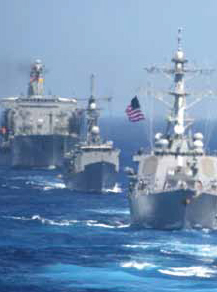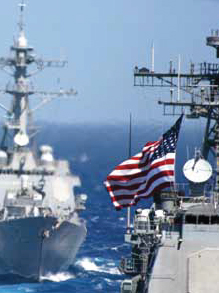REMARKS FROM THE CHAIR AND THE DIRECTOR

Forty years ago the Naval Studies Board was created at the request of then Chief of Naval Operations Admiral Elmo R. Zumwalt, Jr. As stated in his request to the National Academy of Sciences, he thought it important for the Navy to have an outside resource to which it could turn “for independent and outside counsel on any area of its responsibilities involving the interplay of scientific and technical matters with other national issues.” Admiral Zumwalt, together with Under Secretary of the Navy Honorable David S. Potter and President of the National Academy of Sciences Dr. Philip Handler, recognized the importance of not only continuing but also focusing and strengthening the relationship that had existed between the National Academy of Sciences and the Department of the Navy since the Academy’s creation in 1863.
The relationship between the National Academies—National Academy of Sciences, National Academy of Engineering, Institute of Medicine, and National Research Council—and the Navy has a long and distinguished history. The mutual trust and respect that has existed between the National Academies’ naval advisory activities and committees—including the Committee on Undersea Warfare (1946 to 1974), the Mine Advisory Committee (1951 to 1974), and the Naval Studies Board (1974 to the present)—and the Navy has reaped benefits for the nation and its naval forces.
In its first year of existence in 1863, the National Academy of Sciences responded to a Navy request to investigate magnetic deviations in iron ships and means for better correction of their compasses. The study committee recommended removing one of two binnacles in the pilot house and further went on to accurately determine the degree of local attraction from adjacent engines, boilers, iron rigging, and other metal items. In the 1950s, the Committee on Undersea Warfare, at the request of Admiral Arleigh Burke, concluded that technology (warhead size reduction, solid rocket fuel, and such) was indeed now in hand to produce a strategic nuclear-powered submarine. The first of the Polaris submarines went to sea 18 months later.
Since its inception in 1974, the Board has been instrumental in advising the naval forces on means for using space-based systems to meet operational objectives, on identifying future technology options for designing next-generation carriers and supporting naval aviation, on countering mine threats, on enhancing power projection
capabilities, and on using information systems (communications, radar, computers) to meet operational needs. The Board also has conducted significant long-range forecasting studies designed to anticipate new technology-based capabilities and serve as a source of guidance for the Navy’s research efforts.
In recent years, the Board has taken an active role in addressing the needs of the combined naval forces—the Navy, Marine Corps, and Coast Guard team—as it has examined technological opportunities for supporting, meeting, and enhancing operational strategies and concepts laid out in the U.S. maritime cooperative strategy A Cooperative Strategy for 21st Century Seapower. Indeed, recent National Research Council studies conducted under the Board’s auspices have yielded reports—U.S. Naval Forces’ Capabilities for Responding to Small Vessel Threats, Maritime Security Partnerships, and The Role of Naval Forces in the Global War on Terror—aimed at strengthening the U.S. maritime cooperative strategy.
Today’s naval forces face a rapidly changing security environment and a changing and equally uncertain fiscal environment. The future will demand that the nation’s naval forces deter and counter threats different from those defined at the Board’s inception in 1974. Terrorism, cyberwarfare, weapons of mass destruction, and other threats will need to be anticipated and addressed. The science, engineering, and technical community working together with the naval forces can provide the technologies and concepts needed to bolster operational capabilities to address these threats.
In the coming years, the Naval Studies Board will continue to serve as a source of independent, long-range, scientific and technical planning advice for the nation’s naval forces. It will also work to ensure that the relationships between the operational, science, engineering, and technical communities remain as strong and productive as ever to ensure that progress continues in areas most critical to meeting future naval forces’ needs.
 |
|
| MIRIAM E. JOHN Chair |
CHARLES F. DRAPER Director |



